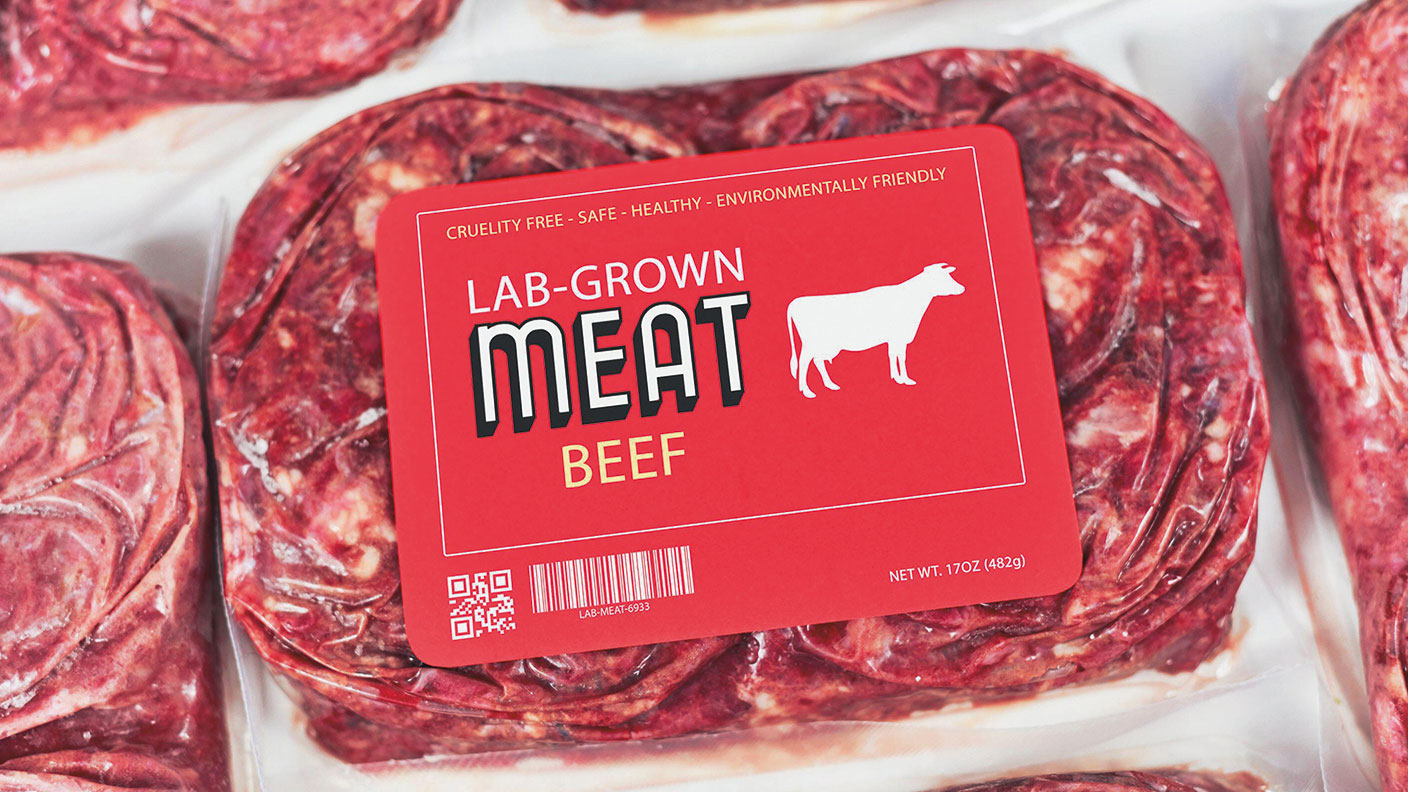Lab-grown meat: how “moo’s law” will drive innovation
Jim Mellon and Anthony Chow, co-founders of Aim-listed Agronomics, explain why they believe that “cellular agriculture” will benefit from massive long-term growth as “Moo’s Law” kicks in.

About three years ago, we became interested in prospects for what’s known as “cellular agriculture”, and the two of us founded Agronomics, via a listed Aim shell company. The shares have done very well, as investors have learned more about the prospects for making food and materials in laboratories and factories, without animal cruelty and slaughter. However, the industry is still nascent. We’d consider it as perhaps being at the equivalent of the dial-up phase of the internet, which means that prospects for super-charged growth are excellent.
Here are some “back of an envelope” predictions. The dairy industry as we know it today (with cows in sheds being milked almost continuously and generally in abject circumstances) will be gone in 15 years. Alternative milks, such as almond, soya and oat milks – Swedish company Oatly is about to go public with a rumoured $10bn valuation – are already gobbling up market share from traditional producers.
These plant-based milks are not necessarily better for either human health or for the environment. For example, almond production uses prodigious amounts of water. But these plant-based milks are just the vanguard of what will be the main disrupting force in the production of dairy products (milk, cheese, yoghurts and infant formula). This will come from precision fermentation, where casein and whey are replicated in laboratory-like conditions, by companies such as Perfect Day, Legendairy and NoQuo. These companies’ products will be effectively replicas of “normal” dairy products. And they will be in widespread use within three years.
MoneyWeek
Subscribe to MoneyWeek today and get your first six magazine issues absolutely FREE

Sign up to Money Morning
Don't miss the latest investment and personal finances news, market analysis, plus money-saving tips with our free twice-daily newsletter
Don't miss the latest investment and personal finances news, market analysis, plus money-saving tips with our free twice-daily newsletter
Going beyond Beyond Meat
Then take meat and fish – any meat, any fish, any species. All of the companies we have in our Agronomics portfolio have prototypes that you can eat or, in the case of materials, feel. Some of these companies will be selling their products to consumers within a year or so. This is despite lobbying from what we call “the agro Luddites”, who are resisting the progress of lab-grown meat and fish. We are confident that half of all meat in the world will be plant-based or cellular-agriculture-based within ten years, and in the case of fish, possibly sooner.
MoneyWeek readers will be familiar with the march of plant-based meats in recent years. Beyond Meat has already gone public in the US, with a valuation of more than $9bn and it is rumoured that its great rival, Impossible, will shortly be going public via a special purpose acquisition company (SPAC) at a valuation of about $10bn. In the UK, home-grown companies such as Meatless Farms and Quorn are seeing rapid growth. In Europe, one of our favourites, LiveKindly, is doing well with its chicken substitutes.
But the really exciting opportunity for us is in lab-grown foods and materials, and not so much in plant-based ones. Why? For one thing, the cellular-agriculture companies typically have more intellectual property than the plant-based companies. For another, ultimately, we believe that at scale the products of the cellular-agriculture companies can be priced more cheaply than conventional foods (hence the title of Jim’s recent book, Moo’s Law, a riff on Moore’s Law, which refers to the process by which computers become more powerful even as costs decrease). Jim calls the point at which the price of alternative foods falls to that of conventional foods “griddle parity” (another riff, this time on “grid parity” in the energy industry). For plant-based foods, this might be as soon as next year in some cases, and in cellular-agriculture-based foods, maybe in five years’ time.
The power of griddle parity
“Griddle parity” is key. Some informed and committed consumers are influenced by the environmental destruction wrought by intensive farming and fishing, by the pandemic risks posed by animal husbandry (80% of all antibiotics go into animals), and by animal cruelty. But the reality is that most consumers care about four things: taste, texture, convenience and price. As far as the first three go, there is already no difference between cellular-agriculture products and those from conventional seafood or meat companies. But when it comes to price, cellular-agriculture processes are currently expensive because they use biotech inputs.
However, that is changing. The costs of the bioreactors, the “media” (the feedstock to grow the cells needed to produce the meat, seafood and materials) and growth factors needed to fast track the production of the foods and products, are coming down. There are remarkable investment opportunities in this field, but as yet nothing is public in the sector apart from Agronomics in London.
Its investments include BlueNalu, a cellular-agriculture seafood company, which will be in the US market by the end of this year. Then there is VitroLabs, which produces and sells leather of the highest quality, none of which comes from a cow (except for the progenitor stem cells). Meanwhile, Legendairy will shortly be producing mozzarella, again without resort to animals. The list goes on. We estimate that the total addressable market for the foods, seafood, and materials that we are investing in is around $5trn – about twice the size of the UK economy. You can see why we’re excited about this opportunity.
Get the latest financial news, insights and expert analysis from our award-winning MoneyWeek team, to help you understand what really matters when it comes to your finances.
-
 The investing mistakes not to make: MoneyWeek Talks
The investing mistakes not to make: MoneyWeek TalksPodcast MoneyWeek's digital editor speaks to Andrew Craig, founder of Plain English Finance, about why passive investing isn't always the only option for good investors
-
 Household savings ratio drops – are you setting enough aside for 2026?
Household savings ratio drops – are you setting enough aside for 2026?High inflation has pushed the savings ratio down again and the figure could dip further next year
-
 Stock markets have a mountain to climb: opt for resilience, growth and value
Stock markets have a mountain to climb: opt for resilience, growth and valueOpinion Julian Wheeler, partner and US equity specialist, Shard Capital, highlights three US stocks where he would put his money
-
 The steady rise of stablecoins
The steady rise of stablecoinsInnovations in cryptocurrency have created stablecoins, a new form of money. Trump is an enthusiastic supporter, but its benefits are not yet clear
-
 SRT Marine Systems: A leader in marine technology
SRT Marine Systems: A leader in marine technologySRT Marine Systems is thriving and has a bulging order book, says Dr Michael Tubbs
-
 Goodwin: A superlative British manufacturer to buy now
Goodwin: A superlative British manufacturer to buy nowVeteran engineering group Goodwin has created a new profit engine. But following its tremendous run, can investors still afford the shares?
-
 A change in leadership: Is US stock market exceptionalism over?
A change in leadership: Is US stock market exceptionalism over?US stocks trailed the rest of the world in 2025. Is this a sign that a long-overdue shift is underway?
-
 A reckoning is coming for unnecessary investment trusts
A reckoning is coming for unnecessary investment trustsInvestment trusts that don’t use their structural advantages will find it increasingly hard to survive, says Rupert Hargreaves
-
 Metals and AI power emerging markets
Metals and AI power emerging marketsThis year’s big emerging market winners have tended to offer exposure to one of 2025’s two winning trends – AI-focused tech and the global metals rally
-
 8 of the best houses for sale with beautiful fireplaces
8 of the best houses for sale with beautiful fireplacesThe best houses for sale with beautiful fireplaces – from a 15th-century cottage in Kent to a 17th-century palazzo in Oxfordshire